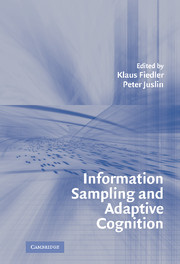Book contents
- Frontmatter
- Contents
- List of Contributors
- PART I INTRODUCTION
- PART II THE PSYCHOLOGICAL LAW OF LARGE NUMBERS
- PART III BIASED AND UNBIASED JUDGMENTS FROM BIASED SAMPLES
- PART IV WHAT INFORMATION CONTENTS ARE SAMPLED?
- 11 What's in a Sample? A Manual for Building Cognitive Theories
- 12 Assessing Evidential Support in Uncertain Environments
- 13 Information Sampling in Group Decision Making: Sampling Biases and Their Consequences
- 14 Confidence in Aggregation of Opinions from Multiple Sources
- 15 Self as Sample
- PART V VICISSITUDES OF SAMPLING IN THE RESEARCHER'S MIND AND METHOD
- Index
- References
14 - Confidence in Aggregation of Opinions from Multiple Sources
Published online by Cambridge University Press: 02 February 2010
- Frontmatter
- Contents
- List of Contributors
- PART I INTRODUCTION
- PART II THE PSYCHOLOGICAL LAW OF LARGE NUMBERS
- PART III BIASED AND UNBIASED JUDGMENTS FROM BIASED SAMPLES
- PART IV WHAT INFORMATION CONTENTS ARE SAMPLED?
- 11 What's in a Sample? A Manual for Building Cognitive Theories
- 12 Assessing Evidential Support in Uncertain Environments
- 13 Information Sampling in Group Decision Making: Sampling Biases and Their Consequences
- 14 Confidence in Aggregation of Opinions from Multiple Sources
- 15 Self as Sample
- PART V VICISSITUDES OF SAMPLING IN THE RESEARCHER'S MIND AND METHOD
- Index
- References
Summary
To the memory of my friend and colleague, Janet A. Sniezek
(1951–2003)This chapter summarizes research related to several interrelated questions regarding the process by which single decision makers (DMs) aggregate probabilistic information regarding a certain event from several, possibly asymmetric, advisors who rely on multiple and, possibly overlapping and correlated, sources of information. In particular I seek to understand and characterize (a) the nature of the aggregation rules used by DMs and (b) the factors that affect the DMs' confidence in the final aggregate.
The chapter starts with a short literature overview whose main goal is to set the stage by placing this work within the broad area of information aggregation. Next I present a descriptive model of confidence in information integration that is based on two principles: (a) People combine multiple sources of information by applying simple averaging rules; and (b) the DM's level of confidence in the aggregate is a monotonically decreasing function of its perceived variance. Some of the model's predictions regarding the structural and natural factors that affect the DM's confidence are discussed and tested with empirical data from four experiments (Budescu & Rantilla, 2000; Budescu et al., 2003). The results document the relation between the DM's confidence and the amount of information underlying the forecasts (number of advisors and cues), the advisors' accuracy, and the distribution of cues over judges with special attention to the level of interjudge overlap in information.
Information
- Type
- Chapter
- Information
- Information Sampling and Adaptive Cognition , pp. 327 - 352Publisher: Cambridge University PressPrint publication year: 2005
References
Accessibility standard: Unknown
- 12
- Cited by
